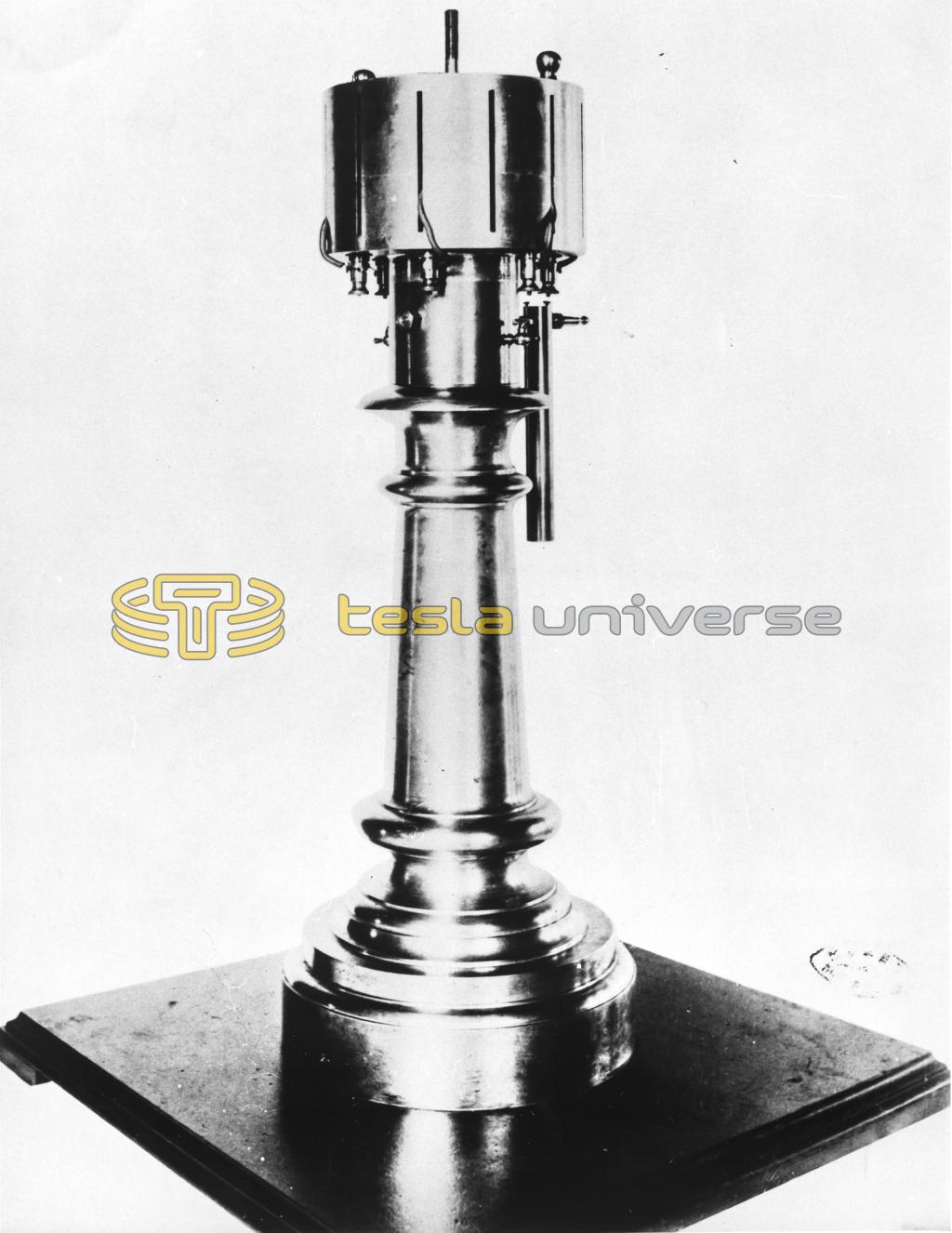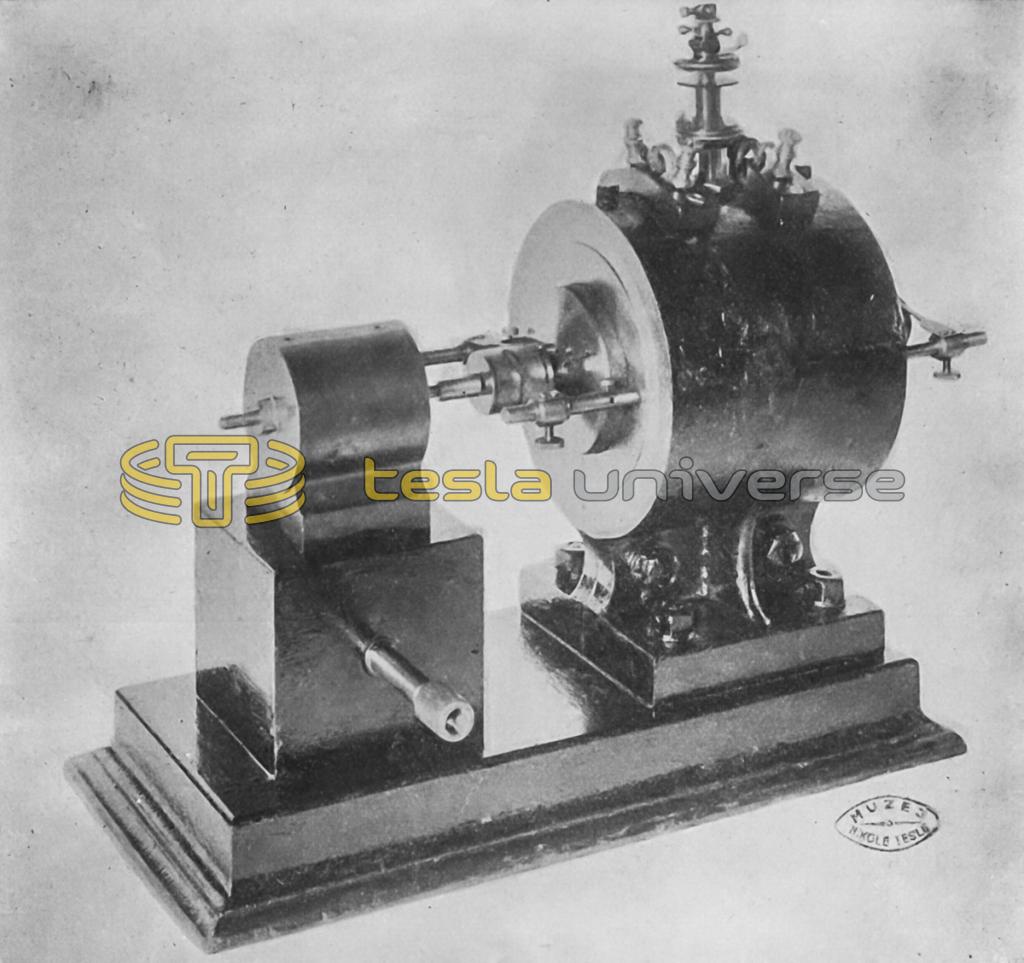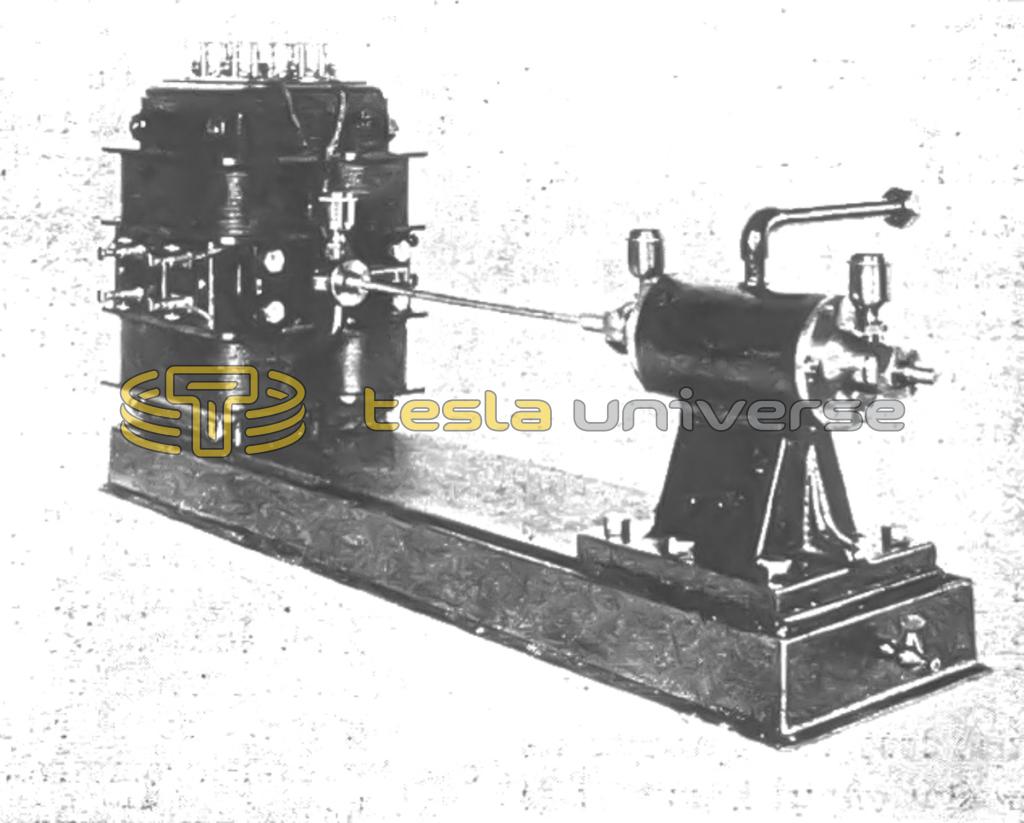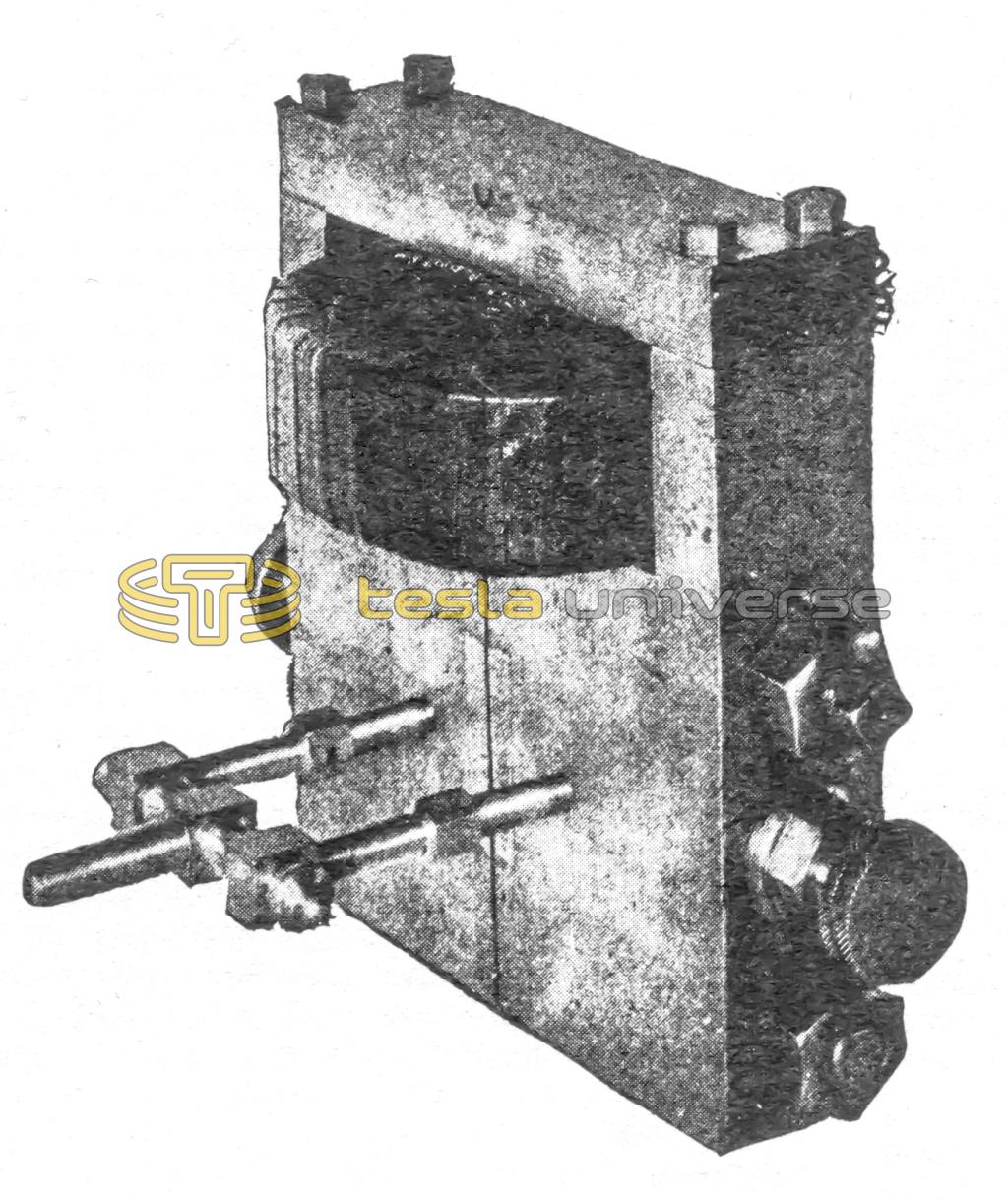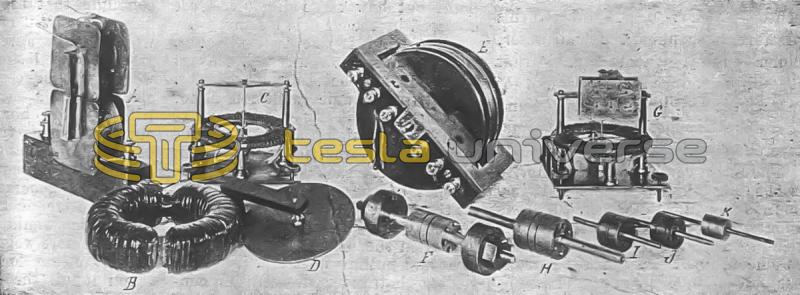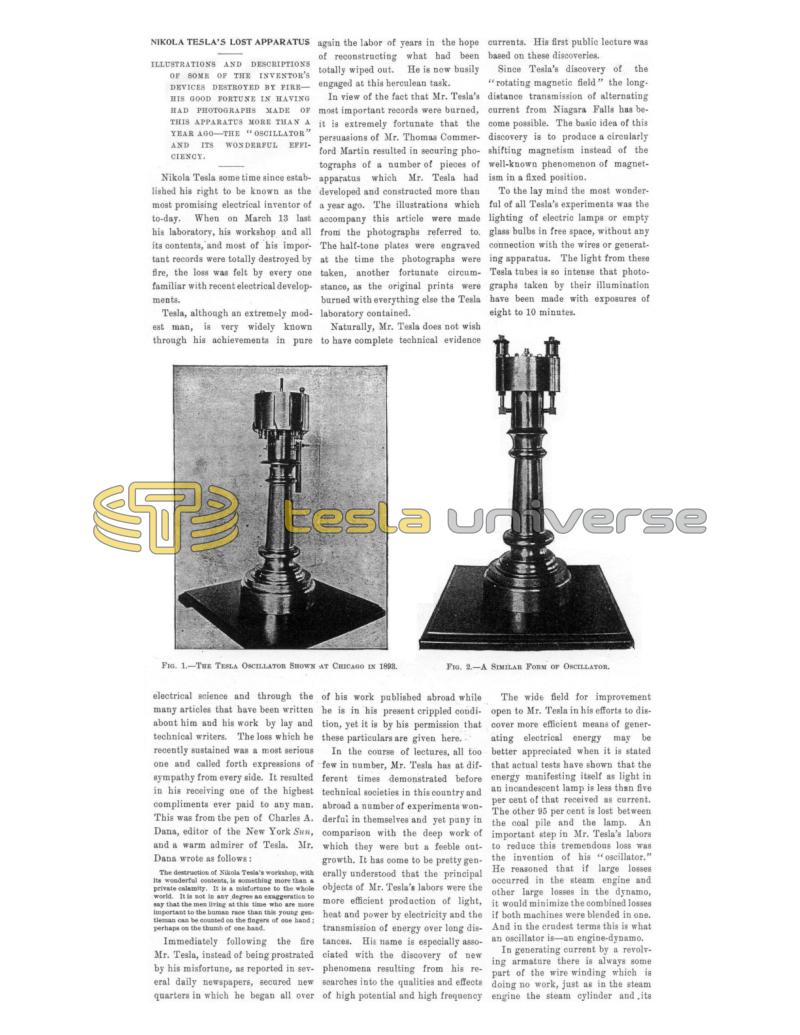
Nikola Tesla Articles
Nikola Tesla's Lost Apparatus
Illustrations and descriptions of some of the inventor's devices destroyed by fire - his good fortune in having photographs made of this apparatus more than a year ago - the "oscillator" and its wonder efficiency.
Nikola Tesla some time since established his right to be known as the most promising electrical inventor of to-day. When on March 13 last his laboratory, his workshop and all its contents, and most of his important records were totally destroyed by fire, the loss was felt by every one familiar with recent electrical developments.
Tesla, although an extremely modest man, is very widely known through his achievements in pure
electrical science and through the many articles that have been written about him and his work by lay and technical writers. The loss which he recently sustained was a most serious one and called forth expressions of sympathy from every side. It resulted in his receiving one of the highest compliments ever paid to any man. This was from the pen of Charles A. Dana, editor of the New York Sun, and a warm admirer of Tesla. Mr. Dana wrote as follows:
The destruction of Nikola Tesla's workshop, with its wonderful contents, is something more than a private calamity. It is a misfortune to the whole world. It is not in any degree an exaggeration to say that the men living at this time who are more important to the human race than this young gentleman can be counted on the fingers of one hand; perhaps on the thumb of one hand.
Immediately following the fire Mr. Tesla, instead of being prostrated by his misfortune, as reported in several daily newspapers, secured new quarters in which he began all over again the labor of years in the hope of reconstructing what had been He is now busily totally wiped out. engaged at this herculean task.
In view of the fact that Mr. Tesla's most important records were burned, it is extremely fortunate that the persuasions of Mr. Thomas Commerford Martin resulted in securing photographs of a number of pieces of apparatus which Mr. Tesla had developed and constructed more than a year ago. The illustrations which accompany this article were made from the photographs referred to. The half-tone plates were engraved at the time the photographs were taken, another fortunate circumstance, as the original prints were burned with everything else the Tesla laboratory contained.
Naturally, Mr. Tesla does not wish to have complete technical evidence of his work published abroad while he is in his present crippled condition, yet it is by his permission that these particulars are given here.
In the course of lectures, all too few in number, Mr. Tesla has at different times demonstrated before technical societies in this country and abroad a number of experiments wonderful in themselves and yet puny in comparison with the deep work of which they were but a feeble outgrowth. It has come to be pretty generally understood that the principal objects of Mr. Tesla's labors were the more efficient production of light, heat and power by electricity and the transmission of energy over long distances. His name is especially associated with the discovery of new phenomena resulting from his researches into the qualities and effects of high potential and high frequency currents. His first public lecture was based on these discoveries.
Since Tesla's discovery of the "rotating magnetic field" the long-distance transmission of alternating current from Niagara Falls has become possible. The basic idea of this discovery is to produce a circularly shifting magnetism instead of the well-known phenomenon of magnetism in a fixed position.
To the lay mind the most wonderful of all Tesla's experiments was the lighting of electric lamps or empty glass bulbs in free space, without any connection with the wires or generating apparatus. The light from these Tesla tubes is so intense that photographs taken by their illumination have been made with exposures of eight to 10 minutes.
The wide field for improvement open to Mr. Tesla in his efforts to discover more efficient means of generating electrical energy may be better appreciated when it is stated that actual tests have shown that the energy manifesting itself as light in an incandescent lamp is less than five per cent of that received as current. The other 95 per cent is lost between the coal pile and the lamp. An important step in Mr. Tesla's labors to reduce this tremendous loss was the invention of his "oscillator." He reasoned that if large losses occurred in the steam engine and other large losses in the dynamo, it would minimize the combined losses if both machines were blended in one. And in the crudest terms this is what an oscillator is an engine-dynamo.
In generating current by a revolving armature there is always some part of the wire winding which is doing no work, just as in the steam engine the steam cylinder and its piston are the only parts doing any work, all the other complex mechanism being used for control or regulation. In brief and popular terms, the Tesla oscillator consists of a bedplate, in the middle of which is located a steam chest. On each side of the steam chest is an electro-magnetic system consisting of field coils, between which the armatures move.
Two pistons are worked by the steam entering the chest. In one case steam at 350 pounds pressure is used, although as low as 80 pounds is used in other oscillators. At the ends of the pistons are the armature coils, which are thrust in and out of the magnetic fields with a reciprocating motion, thus generating current.
Here, then, is a steam engine stripped of every inefficient complication, and at the same time it is an electrical generator in which every part is doing steady work. The oscillator keeps the high pressure steam under such control that no packing is required to prevent leakage. For the same pressure and the same piston speed the engine part of the oscillator has but one-thirtieth to one-fortieth of the usual weight and consequently occupies a proportionately smaller space. The reduction of bulk and space occupied is also true of the electrical portion of the oscillator. Mr. Tesla believes that in the development of this apparatus he has reached a long way in advance in the reduction of the wasteful processes now present in the generation of electric current from coal.
The most highly developed form of oscillator, and one that was entirely practical and successful, had been used for many months in Tesla's laboratory. It was used to light the rooms with incandescent lamps and also furnished current for four arc lamps, for motors, for experiments with the high frequency apparatus and for other investigations. Many visitors to the laboratory have witnessed this oscillator in successful operation.
The oscillator which Mr. Tesla used in his lecture before the International Electrical Congress, during the World's Fair at Chicago, in August, 1893, is the only one that has ever been exhibited in public. This is shown in the accompanying illustration, Fig. 1. For convenience, compressed air instead of steam was used to operate this oscillator during Mr. Tesla's lecture. The machine consists of an engine mounted on an ornamental column, on top of which is a generator much like that shown at E in Fig. 6. In Fig. 2 is illustrated a similar form without the generator. A very strong air spring is contained in the box on top of the column. The apparatus is so constructed that the vibrations of this spring and the engine are always in perfect synchronism. The only possible function of the engine is to keep the spring vibrating. Eventually the amplitude of the vibration will be altered, but the period will remain the same; that is, it is the natural period of vibration of the system. The recoil of the spring is, of course, very much greater than the impulse received each time from the engine. Around the spring is a chamber which can be maintained at a constant temperature by any usual means. The isochronism is perfect because the frictional losses are infinitesimally small compared with the enormous elastic force.
Another quite distinct type is illustrated in Fig. 3. On a stand with a dynamo of somewhat unusual form is mounted a small oscillator. The dynamo includes a circular field magnet in which circular coils are arranged to move on each side. An arbor directly connected to the small engine carries the coils, and currents are produced by vibrating the coils within the field of the magnet. Mr. Tesla says that in this form there is absolutely no useless wire. All of it is within the field and all is equally active.
An oscillator of more advanced form, operated by steam and freely used for laboratory purposes, is shown in Fig. 4. This extremely small machine had a capacity of 12 incandescent lights. The combination was made up of a small oscillator and a dynamo having a field magnet with exciting coils and an armature simply of iron. The induced coils were wound on a number of pole projections extending from the inside of the magnet. The armature had fewer projections than the field and in this way the output of the dynamo was increased by the number of teeth.
An extremely interesting piece of experimental apparatus, used solely for scientific research, is shown in Fig. 5. It consisted of a field magnet within which there was arranged to vibrate a tongue of steel carrying at its end a coil. Both the tongue and coil were vibrated in the strong field, adjusting screws on each side allowed the attainment of any periodicity within a wide range.
A most interesting group of parts used by Mr. Tesla in his demonstrations is illustrated in Fig. 6. Novel features were exemplified by the use of several of the instruments shown. As an example, the magnets in A served to make clear the principle of the preponderance of one impulse over the other in the current produced by the oscillator and creating virtually the effect of a direct or continuous current. A magnet which was vibrated is shown in R. The copper disk D was arranged to rotate freely in bearings. When the disk was held between the poles, that is, in the field of the vibrating ring magnet, it was rotated in one direction. This showed that the currents distributed in the disk were asymmetrical, or in other words, they were preponderating in one direction.
The constancy or invariability of the speed of the oscillator was illustrated by the use of the little motor shown at C in Fig. 6. Another little motor with clock work attached, shown in G, was used to count the revolutions of the oscillator. Both of these little motors were driven from one circuit, the difference of phase being obtained by artificial means. E was a little generator comprising three coils, two inducing and one induced, and an iron coil which was vibrated by the oscillator to which it was attached. The parts of an oscillator for short and long strokes, respectively, are shown in Fig. 6 at F, H, I, J and K.
These are only a very few of the Tesla devices which are now blackened ruins; yet they will serve to give a faint idea of the great and interesting achievements which this inventor has been accomplishing. Mr. Tesla is successfully at work reproducing his lost records and apparatus. The sympathy and encouragement he has received since his misfortune occurred will doubtless result in spurring him on to still greater and more brilliant efforts which an appreciative public will not be slow to recognize.
